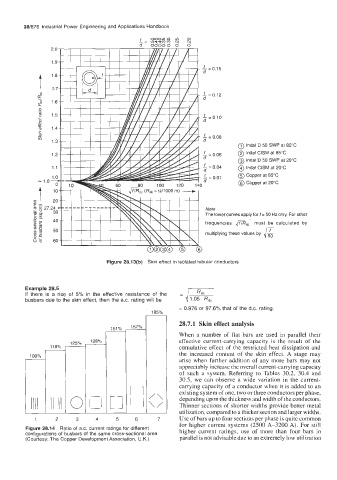Page 926 - Industrial Power Engineering and Applications Handbook
P. 926
28/876 Industrial Power Engineering and Applications Handbook
OInOlOO In
I= Inb*@-Jrn N z
d ooooo o o
1=015
d
'GO12
d
t -=010
d
1=008
d
@ lndal D 50 SWP at 85°C
I = o6 @ lndal ClSM at 85°C
d
@ lndal D 50 SWP at 20°C
= 0 04 @) lndal ClSM at 20°C
d
@ Copper at 85°C
'=OOl
d @ Copper at 20°C
Note
The lower curves apply for f= 50 Hz only For other
frequencies must be calculated by
multiplying these values by &
Figure 28.13(b) Skin effect in isolated tubular conductors
Example 28.5
If there is a rise of 5% in the effective resistance of the
busbars due to the skin effect, then the ax. rating will be
= 0.976 or 97.6% that of the d.c. rating
28.7.1 Skin effect analysis
151%
When a number of flat bars are used in parallel their
~
128%
125%
- effective current-carrying capacity is the result of the
118%
- cumulative effect of the restricted heat dissipation and
100%
- the increased content of the skin effect. A stage may
arise when further addition of any more bars may not
appreciably increase the overall current-carrying capacity
of such a system. Referring to Tables 30.2, 30.4 and
30.5, we can observe a wide variation in the current-
carrying capacity of a conductor when it is added to an
-- existing system of one, two or three conductors per phase,
1111 II II 0 LA depending upon the thickness and width of the conductors.
Thinner sections of shorter widths provide better metal
utilization, compared to a thicker section and larger widths.
1 2 3 4 5 6 7 Use of bars up to four sections per phase is quite common
for higher current systems (2500 A-3200 A). For still
Figure 28.14 Ratio of ax. current ratings for different
configurations of busbars of the same cross-sectional area higher current ratings, use of more than four bars in
(Courtesy: The Copper Development Association, U.K.) parallel is not advisable due to an extremely low utilization

